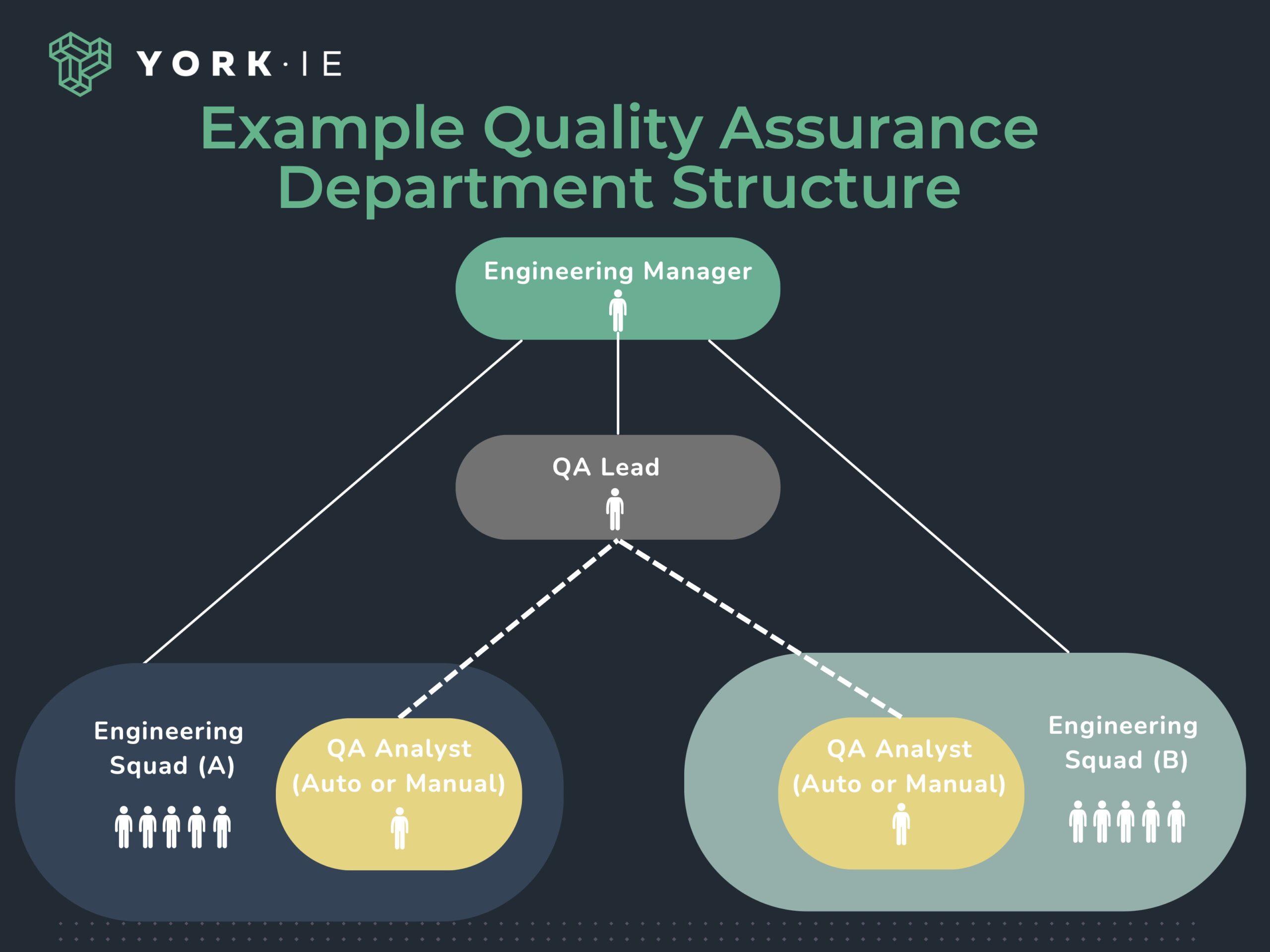The right quality assurance department structure can set up your development team to deliver higher quality releases with fewer bugs – and a better overall customer experience.
A quality assurance (QA) team’s main responsibility is to ensure that the software their colleagues are engineering functions correctly, without impacting new or existing features in a negative manner. Put simply, quality assurance is vital for fast-moving technology companies.
But there’s no one-size-fits-all quality assurance department structure. The QA team for a private-equity-backed enterprise technology company will look a lot different than that of an early-stage startup – both in its size and its methods.
As the CTO of York IE, I oversee our product strategy and development advisory services team. Whether we’re working with early or later-stage clients, we always stress the importance of QA in our engagements. We have robust experience advising clients on how to build a quality assurance organizational chart that fits their needs.
Let’s explore the importance of QA and discuss the ideal quality assurance department structure for your company:
Why Do You Need a Quality Assurance Software Team?
A QA team helps support your product development efforts. They provide a vital backup check and additional expertise to help limit bugs and hiccups once your product reaches your customers. Here are a few key responsibilities of your quality assurance software team:
Ensuring Product Quality
Nobody wants to work with a broken or buggy application. Thorough testing and quality checks help QA professionals identify and rectify any issues in the software before it’s released to end users.
Maintaining Customer Satisfaction
QA analysts typically try to mimic customer behaviors in their testing. Both expected workflows and unexpected misuse are tested. This way, they can help the engineering team check the software against common customer issues.
Limiting Costly Bugs and Errors
Teams that spend more time identifying and fixing bugs early on spend 22% less time on unplanned work and rework, and 29% more time on new, value-adding work. Product bugs and errors tend to have a compounding effect; the quicker you identify them, the less likely they are to delay your timelines.
Meeting Compliance and Regulatory Requirements
Companies in industries such as healthcare, finance, aviation and defense often face strict regulatory standards. A quality assurance software team can help ensure that all standards are met, and thus reduce the risk of non-compliance penalties or legal issues.
Fostering Continuous Improvement
QA teams don’t just judge the quality of your software. They’re also evaluating the development process and providing feedback based on their testing results. As QA specialists get more ingrained with their engineering team, they’ll be able to anticipate roadblocks and provide feedback during feature planning, keeping the team aligned with the product roadmap.
What Are the Three Main Types of QA?
Before we discuss the ideal quality assurance organizational chart, it’s important to understand a few of the different types of QA. Each method is typically closely tied to the stage of the company, and its product pain points:
Developer-Led QA
As the name suggests, developer-led QA empowers developers to take ownership of the software testing process. Developers test the functionality of the features, web pages or tools they’ve written themselves. Each developer is responsible for documenting the requirements of their part of the system.
Every organization begins with developer-led QA, especially early-stage companies working on an MVP. As your engineering function matures, you’ll likely see a need for dedicated QA specialists.
Manual QA
Manual QA brings a secondary party into the equation. In this case, a QA analyst or specialist will typically embed themselves within the engineering team. They’ll open up the platform or application and run it as it’s supposed to be used, sharing their feedback with the developer.
The advantage here is that the QA tester didn’t write the code themselves. They don’t have the inherent knowledge of how the software is supposed to work. QA professionals are also skilled at “breaking software”; they know which buttons to push to stress-test the product. They’ll be responsible for writing test cases, and performing regression testing (ensuring that old features still work correctly as you introduce new ones).
Automated QA
Automated test frameworks help companies streamline repetitive tasks and ensure consistent testing. Many QA analysts will use automated tools to free up their time for more strategic tasks. As with any automated tool, it’s important to have a human check and not rely strictly on your testing software.
Later-stage companies with significant revenue, sensitive customer data, or complex launches will likely invest heavily in automated QA tools.
How Do You Structure a QA Department?
A quality assurance team is generally led by QA lead who oversees a team of QA analysts or engineers. The QA lead, who reports up to the leader of the engineering org, is responsible for guiding the QA team and defining the test process. QA analysts are embedded within the company’s engineering squads to foster continuous improvement.
Below, we’ve produced an example quality assurance organizational chart. Let’s walk through the key roles and responsibilities:

Engineering Manager
Atop the quality assurance organizational chart sits the engineering manager. This technical leader will oversee the entire product development process, including QA. In the graphic above, you’ll see that the manager commands two engineering squads, which might be working on separate products or feature sets.
At an early-stage organization, this could be the CTO or VP of engineering. Later-stage companies might also employ a software engineering manager or product development manager.
Quality Assurance Lead
Leading the quality assurance software team is the QA Lead, who reports directly to the engineering manager. Their role is to define and refine the QA process, including best practices. A QA Lead typically works closely with the engineering manager and customer to select testing tools and define test strategy and test planning. They’ll assign tasks to the QA analysts and ensure smooth communication between developers and testers. The QA lead ensures proper test design and test execution quality.
Quality Assurance Analysts
A QA analyst could go by many names: QA engineer, QA specialist, test automation engineer, etc. They’re the hands-on testers who execute the QA strategy. Quality assurance analysts will typically design and conduct test cases, and use their keen eye for detail to detect bugs and defects.
As you’ll see in the graphic above, QA analysts are embedded within an engineering team. They’ll typically build a relationship with developers and improve their testing over time. At York IE, we often recommend a QA-analyst-to-developer ratio of between 3:1 and 7:1, depending on the complexity and speed of your launches.
In the early stages, a QA analyst will oversee all parts of the quality assurance process. As organizations mature, they might require specialists in areas such as user experience, usability or integrations.
Automation Tools
Automation tools play an important role in many companies’ quality assurance department structure. These tools can be very effective; 24% of organizations that made test automation investments experience an immediate return on investment.
Even at the earlier stages, we recommend exploring test management tools such as Testrail and Zypher by SmartBear. They’ll help speed up the QA process and support your QA org as you scale.
The Importance of A Strong Quality Assurance Department Structure
York IE is a big believer in baking quality assurance software professionals into all of our development squads. We identify our clients’ need for either fractional or full-time QA allocation and offer deep experience in both manual and automated QA. We’ll help you select the quality assurance department structure that works for you.
Our emphasis on QA makes us different from many outsourced development teams. Click the button below to learn how our approach can help you deliver higher-quality releases to your customers in less time.



